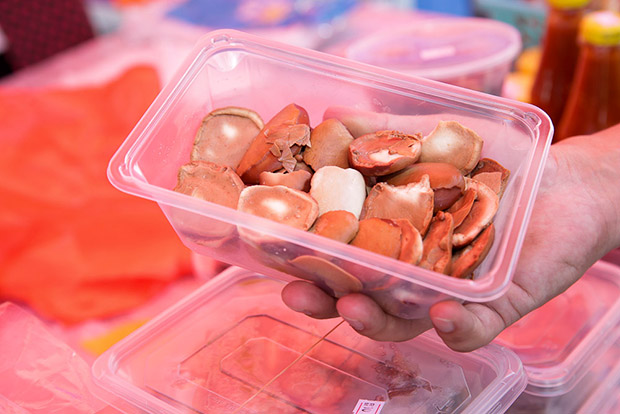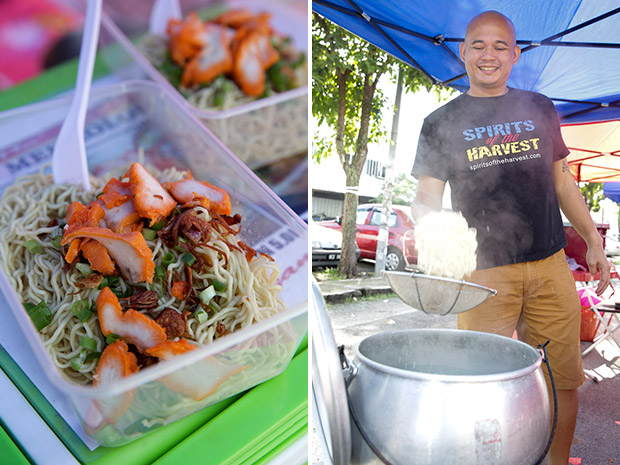KUALA LUMPUR, May 14 — Broaden your horizons by visiting the Pasar Borneo held every Saturday at Seri Kembangan. At this community market that has around 20-25 stalls, you have a chance to sample a slice of the Borneo culture without hopping onto an aeroplane.
Started in April last year, the idea was mooted by local Iban community leader Duwen Babat to Serdang MP Ong Kian Ming as a way to help the Borneo folks do business here.
These stalls are run by Borneo folks who have relocated to the Klang Valley. Most of them are doing this business on a part-time basis.
If you are clueless about what the items are, just ask around and they will be happy to educate you. Customers come from as far as Melaka, Penang and Klang to buy their Borneo products.
The market is also a treasure trove for fresh produce. Foreign to us locals, these are ingredients that most Sabahans and Sarawakians love and grew up with.

For instance, Midin or the fresh fern tops unique to Sarawak, hence the ones sold here are brought over. Similarly, the Terung Iban, Daun Sabong and the list goes on.
If you have a green thumb, there is one stall selling the seeds for these vegetables and chillies. Try growing these indigenous vegetables on your own, just like how Ling Sanggau has done.
The lady peddles Ensabi Dayak which can be sold out within one hour of opening her stall. She gets a farmer in Puchong to plant the leafy vegetable that has a similar taste to mustard greens.
There is also the pickled version that has a slightly bitter taste. She also has Cili Putih that is planted locally which is sought after by many Borneo folks for its not too spicy taste.
Another popular ingredient is Tuhau, a type of wild ginger. In the market, it is sold in various forms: fresh, pickled with chilli sauce or even serunding style where it is mixed with coconut milk.
You will notice that almost every stall has their own version of preserved food. Since modern facilities like refrigerators were not easily available in Borneo, food preservation is a big thing.
The preservation also enhances the flavours of the items so people have gotten used to that strong taste. One popular item is Pekasam where fish is preserved with rice. The Sabahans will add Kepayang leaves to the mixture while in Sarawak, they preserve using the Kepayang leaf or seeds that resemble our local Jering.

When eaten raw, the seeds are poisonous. It needs to go through repeated boiling and cleaning to make these crunchy seeds edible.
At the market, you can also find just the Kepayang seeds for sale. Usually it is eaten plain or stir fried with greens. Another method of preservation is salai or smoking.
Usually the fish and chicken is slowly cooked over a slow fire for a few hours. The smoked fish or chicken will usually be cut and used to flavour soup or cooked together with vegetables.
If you are feeling peckish, nibble on a freshly fried kuih penyaram that is sold at almost every stall at the market. This popular snack among the Borneo folks is made from gula apong or the sweetish brown coloured substance processed from the sap extracted from the nipah palm.
You may have spotted a similar kuih here in the Klang Valley but that version usually uses gula Melaka. Wash it down with a bottle of chilled Tenom coffee. The brewed drink is made from Robusta coffee beans from Tenom, Sabah.

There is also kolo mee served from Mee Kolok Aroma (https://www.facebook.com/meekolokaromadepenyangkai/), a stall operated by Raul Fareira. This pork-free version is topped with chicken slices coloured to resemble char siew and fried shallots.
The two-year old stall uses freshly-made kolo mee sourced from a Puchong factory run by a Sarawakian. Raul who used to work in the F&B industry set up his stall at Seri Kembangan’s Restaurant The One. It is just located a few doors away from the Pasar Borneo.
If you are a fan of Sarawak layer cakes, you will be spoiled for choice here. For a more traditional taste, there is Masnah Umbat’s colourful creations. Most of them are steamed varieties while just a few are baked.
She sells around 12 flavours; most popular are the Masam Manis and Chocolate Cheese. You even have one called Selipar Jepun that takes its name from those colourful Japanese slippers, and another called Harimau Malaya as it is similar to the coat of a tiger.
Then there is Luscious Butter Cakes (https://www.facebook.com/lusciousbutterbakes/) run by Cindy Wilfred. She is completely self-taught and started the business eight years ago.
When she was staying in Perlis, she learned how to bake the complicated layer cakes. After many wasted eggs (apparently one cake can use up to 25 eggs!) and discarded uneven layers, she managed to perfect her technique.
Her cakes use a non-traditional method as they are made with less sugar and colouring. She also prefers to bake with butter instead of margarine. Popular orders from her online business include the unusual Kek Belacan, named as such since its shape is compact and dense, just like a block of fermented shrimp paste!

Essentially it is a chocolate cake made with a special brown sugar sourced from Borneo. Other items like her Lumut Cheese and Red Velvet Cheese are also highly sought after.
For those seeking to recreate the taste of the Borneo dishes here, it is important that the right condiments are used. Hence some stalls sell an array of soy sauce and thick soy sauce from trusted brands they grew up with.
Another crowd favourite is Mi Udang, a prawn flavoured dried noodles. Even the chilli sauce is different, as sworn by their locals. Other goodies include a childhood favourite, King Kong biscuits where two types of biscuits — one milky and another coconut based — is packed in a King Kong emblazoned packet.

You can also buy packets of kacangma or motherwort that is ready to cook. This herb is often cooked with chicken as a confinement dish. There is also belacan from Bintulu, a place that is reputed to have the best fermented shrimp paste.
One of our most unusual finds was the pepper mint. Said to be plucked from a plant growing in the jungle, these blackish peppercorns have a strong smell of mint!
Aside from food, there are cultural items sold here. You get to see the intricate art of weaving manik that is done by Ellecia Entia who hails from Simunjan in Sarawak. She picked up the skill by watching videos and also by communicating through a WhatsApp group for fellow weavers from Miri, Bintulu and Sibu.
The talented woman also makes the items upon request. If you are looking for traditional clothes, Masnah who makes the Sarawak layer cakes also has a small selection of Kelabit headgear and Iban selendang.
Pasar Borneo
Jalan Jinma 7
Seri Kembangan
Selangor
Every Saturday from 7am to 11am
Facebook: https://www.facebook.com/pasarborneoSK/






















